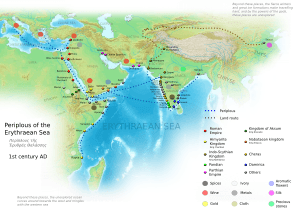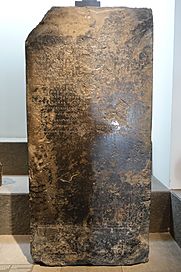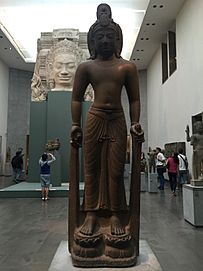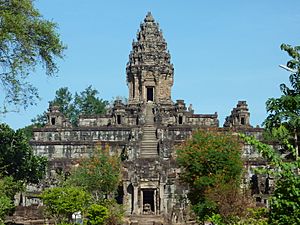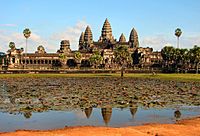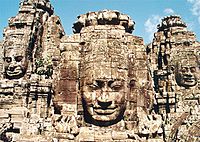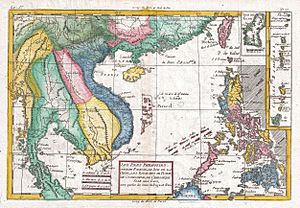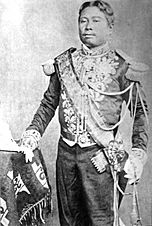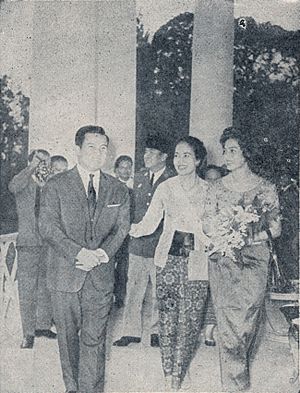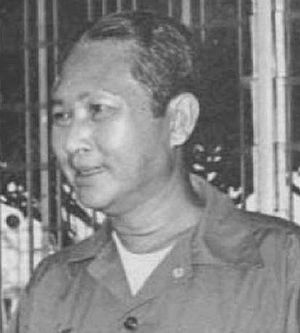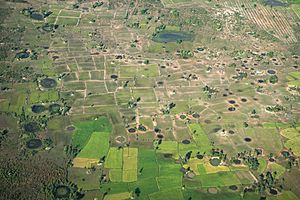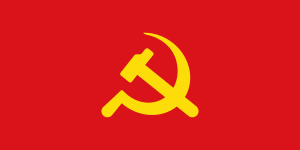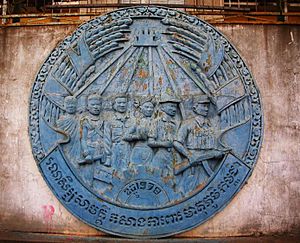History of Cambodia facts for kids
The history of Cambodia is a long and interesting story about a country in Southeast Asia. It goes way back to ancient times, influenced by Indian culture. The first clear records of a government in Cambodia come from Chinese writings about a kingdom called Funan. This kingdom existed from the 1st to the 6th centuries.
Funan was located in the southern part of the Indochinese peninsula, near the Mekong River. It was known as the oldest Hindu culture in the area. This shows that people in Funan traded a lot with others from the Indosphere (areas influenced by Indian culture). By the 6th century, a new civilization called Chenla took over from Funan. Chenla controlled larger areas and had more than one main city.
The amazing Khmer Empire began in the early 9th century. Its founder, Jayavarman II, had a special ceremony at Mount Kulen in 802 CE. This ceremony was meant to show that he was the rightful ruler. Many strong kings followed him, continuing a Hindu tradition where the king was seen as a god (called devaraja). This was the classical era of Khmer civilization, lasting until the 11th century. Later, a new group of rulers brought in Buddhism.
The Khmer Empire achieved great things. They were excellent at governing, farming, architecture, and urban planning. Their water systems were very advanced. All these achievements show how creative and advanced this civilization was. It's a huge part of Southeast Asia's cultural past.
After the 14th century, the Khmer Empire slowly declined. This was followed by a period called the Post-Angkor Period, starting in the mid-15th century. Even though Hindu traditions were mostly gone, the famous temples at the old capital remained important spiritual places. From the mid-15th century, many people moved east. They settled near the Mekong and Tonle Sap rivers, in places like Chaktomuk, Longvek, and Oudong.
The 16th century was a time of wealth thanks to sea trade. However, this also brought more foreigners, like Muslim Malays, Cham people, and Christian European adventurers. These groups started to influence the government. So, the Longvek era had both good times (a strong economy) and bad times (problems with culture and the royal family).
By the 15th century, Cambodia's neighbors, the Siamese/Thai and Annamese/Vietnamese, grew stronger. They saw that controlling the lower Mekong basin was key to controlling all of Indochina. A weak Khmer kingdom made them want to take over more. Attacks on Khmer royal cities and interference in royal family matters weakened the kings. Oudong became the last royal city of this period in 1601.
In the 19th century, powerful European colonial countries arrived. They ended the regional fights. Siam/Thailand managed to avoid being colonized, but Vietnam became a main target for French colonial rule. Cambodia, though often overlooked, became part of the Indochinese Union. This allowed Cambodia to keep its identity and move into modern times.
After 80 years under French rule, World War II brought a short Japanese occupation. This period, along with the crowning of King Sihanouk, started Cambodia's journey towards becoming truly independent. The Kingdom of Cambodia (1953–70) became independent in 1953. It tried to stay neutral during the Cold War, a time when the USA and Soviet Union were in a big global rivalry.
As the Indochinese war grew, Cambodia became more involved. This led to the Khmer Republic in 1970 and a civil war. In 1975, Cambodia faced its darkest time under the Khmer Rouge. This was followed by a long period of Vietnamese occupation, the People's Republic of Kampuchea, and finally, a UN Mandate leading to Modern Cambodia in 1993.
Contents
- Ancient Times and Early Settlements
- Funan Kingdom (1st to 6th Century)
- Chenla Kingdom (6th Century to 802)
- Khmer Empire (802–1431)
- Post-Angkor Period (1431–1863)
- French Colonial Period (1863–1953)
- Sihanouk's Rule (1953–70)
- Khmer Republic and the War (1970–75)
- Democratic Kampuchea (Khmer Rouge Era) (1975–79)
- Vietnamese Occupation and the PRK (1979–93)
- Modern Cambodia (1993–Present)
- Images for kids
- See also
Ancient Times and Early Settlements
Scientists have found ancient stone tools in a cave called Laang Spean in northwest Cambodia. These tools, called Hoabinhian, are from 6000–7000 BCE. Pottery from 4200 BCE was also found. Since 2009, studies at this cave have shown a full history of human culture. This goes from 71,000 years ago to the Neolithic period.
The finds suggest that hunter-gatherer groups lived there first. Later, Neolithic people arrived with advanced hunting skills. They also made beautiful pottery and had complex social and burial practices. Cambodia was part of the "Maritime Jade Road." This trade route was active in the region for 3,000 years, from 2000 BCE to 1000 CE.
Human skulls and bones found at Samrong Sen, in Kampong Chhnang Province, are from 1500 BCE. These people might have come from southeastern China. Scholars believe they were the first to grow rice and make bronze in Southeast Asia. Graves at Phum Snay in northwest Cambodia show many weapons. This suggests that conflicts happened in those ancient times.
The Iron Age in Southeast Asia began around 500 BCE. It lasted until about 500 A.D., the end of the Funan era. During this time, there is clear proof of regular sea trade with India and South Asia. By the 1st century, people had developed complex societies. They had different religious beliefs and spoke languages similar to those used today. The most advanced groups lived along the coast and in the Mekong River valley. They lived in houses on stilts, grew rice, fished, and raised animals.
Funan Kingdom (1st to 6th Century)
Chinese records tell us about the first known organized kingdom in Cambodia and Vietnam. It was called the Kingdom of Funan. This kingdom had many people and big cities. It produced extra food and had different social classes. Its power was supported by Indian religious ideas. Funan was located around the lower Mekong and Bassac rivers. It existed from the 1st to the 6th century CE. It had "walled and moated cities" like Angkor Borei in Takeo Province.
Early Funan was made up of many small communities, each with its own leader. They shared a common culture and economy. People in the countryside grew rice, and traders lived in coastal towns. They depended on each other, as extra rice was sent to the ports.
By the 2nd century CE, Funan controlled the important coastline of Indochina. It also controlled the sea trade routes. Cultural and religious ideas came to Funan through the Indian Ocean trade route. Trade with India had started long before 500 BCE. Funan's language was an early form of Khmer, and its written language was Sanskrit.
Between 245 and 250 CE, officials from the Chinese Kingdom of Wu visited Funan. They described Funan as a distinct Hindu culture. Trade with China began after the Han Dynasty expanded south, around the 2nd century BCE. Funan was important because it controlled both land and coastal trade routes. It was a key "economic and administrative hub" between the Indian Ocean trade network and China. This network was known as the Maritime Silk Road. Roman and Persian coins found at old sites show that trade routes reached as far as Rome.
Funan is linked to old myths. One is the Khmer founding legend. It tells of an Indian prince named Kaundinya (Preah Thaong in Khmer). He married the local princess, Nagi Soma (Lieu-Ye in Chinese records). This story is said to have started the first Cambodian royal family. Scholars discuss if this story is true or a symbol of how Indian beliefs spread.
Chinese records say that Funan was largest in the early 3rd century. Under King Fan Shih-man, it reached as far south as Malaysia and west as Burma. Funan controlled trade and exported many goods. These included forest products, gold, ivory, and spices. King Fan Shih-man had a strong navy and a well-organized government. This government collected taxes and used the wealth to support traders and expand its power.
Historians have different ideas about Funan's political status. Some say it was not a unified state or empire. Others suggest it was an empire with "vassal kingdoms" (smaller kingdoms under its control). The exact way Funan ended is also debated. Chenla is the name of the kingdom that followed Funan in Chinese records, appearing first in 616/617 CE.
Some scholars believe Funan declined because trade routes shifted. Others think Chenla's conquest of Funan caused the trade routes to change. However, some inscriptions from that time do not show any major political break. More archaeological research is helping to understand this early period better.
Chenla Kingdom (6th Century to 802)
Chinese records from the Sui dynasty say that a state called Chenla sent a message to China in 616 or 617 CE. These records state that Chenla was once under Funan's control. But under its ruler Citrasena-Mahendravarman, Chenla conquered Funan and became independent.
However, many historians now question these Chinese records about Chenla. They say the Chinese terms 'Funan' and 'Chenla' were very vague. Also, new Cambodian inscriptions have been found. These inscriptions do not show any major break in royal succession. For example, an inscription from 667 CE does not suggest a political change. This means that historians might have misunderstood the early history of Cambodia by relying too much on Chinese reports.
The idea that Chenla's main city was in modern Laos has also been questioned. It just needed to be inland from Funan. By the late 8th century, Water Chenla became a vassal (under the control) of the Sailendra dynasty from Java. Its last kings were killed, and it became part of the Javanese kingdom around 790 CE. Land Chenla became independent under Jayavarman II in 802 CE.
The Khmers, who were once under Funan, reached the Mekong river from the north. Chenla, their first independent state, grew out of Funanese influence. Ancient Chinese records mention two kings, Shrutavarman and Shreshthavarman. They ruled from the capital Shreshthapura, in what is now southern Laos. The Khmer Kingdom of Bhavapura in modern Kampong Thom had a huge impact on Cambodia's future. Its most important ruler was Ishanavarman. He fully conquered the kingdom of Funan between 612 and 628. He chose his new capital at Sambor Prei Kuk, naming it Ishanapura.
Khmer Empire (802–1431)
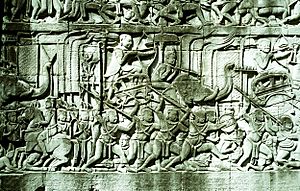
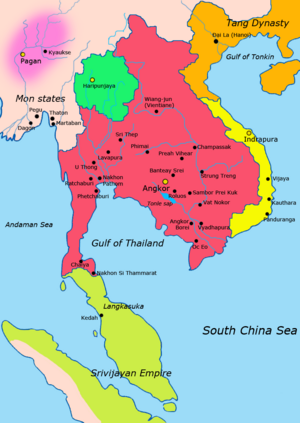
The Khmer Empire lasted for six centuries. This period saw amazing technical and artistic progress. It was a time of strong government and stable rule. The empire represents the peak of Cambodian and Southeast Asian civilization before modern industry.
The Khmer Empire followed Chenla. Chenla was a kingdom with changing power centers. It split into Land Chenla and Water Chenla in the early 8th century. By the late 8th century, Water Chenla was taken over by the Malay Srivijaya Empire and the Javanese Shailandra Empire.
Jayavarman II, the ruler of Land Chenla, started a special Hindu ceremony at Mount Kulen in 802 CE. This was to declare his kingdom's independence and his right to rule. He called himself devaraja, a god-king. This meant he was divinely chosen and had no rivals. He also declared independence from Shailandra and Srivijaya. He built Hariharalaya, the first capital of the Angkor area, near the modern town of Roluos.
Kings like Indravarman I (877–889) and his son Yasovarman I (889–900) built huge water reservoirs (barays). Yasovarman I also founded the capital Yasodharapura. These water systems used channels, ponds, and earth walls. The dikes of the East Baray are still there today. They are over 7 km (4.3 mi) long and 1.8 km (1.1 mi) wide. The largest is the West Baray, about 8 km (5 mi) long and 2 km (1.2 mi) wide. It held about 50 million cubic meters of water.
The government was based on the idea of a Hindu state. The king was seen as a warlord and protector, called the "Varman." This system had royal officials in different provinces. Later, the Mahidharapura dynasty changed some old traditions. They stopped Hinduism from being the only state religion. Some historians think these religious changes contributed to the empire's decline.
The area of the various capitals is now called Angkor. It covered about 1,000 square kilometers (386 sq mi). The people grew wet rice using a clever irrigation system. The Tonlé Sap lake provided lots of fish. This meant there was always plenty of food. Recent studies show that Angkor was the largest pre-industrial city in the world in the 12th and 13th centuries. About three-quarters of a million people lived there. Many workers were used to build monuments and maintain the water systems. Some researchers believe that using too many natural resources, like cutting down too many trees, led to the empire's decline.
Under King Suryavarman II (1113–1150), the empire became its largest. It controlled Indochina, the Gulf of Thailand, and parts of northern maritime Southeast Asia. Suryavarman II ordered the building of Angkor Wat. This temple, built in 37 years, has five towers representing Mount Meru. It is considered the best example of classical Khmer architecture. However, the empire's expansion stopped when Suryavarman II was killed trying to invade Đại Việt. This led to problems within the royal family and an invasion by the Cham in 1177, who sacked Angkor.

King Jayavarman VII (ruled 1181–1219) is often seen as Cambodia's greatest king. He was a Mahayana Buddhist. He started his rule by successfully fighting back against Champa. During his nearly 40 years as king, he built more monuments than any other ruler. He built the city of Angkor Thom with its central temple, the Bayon. Other famous works include Banteay Kdei, Ta Prohm, Neak Pean, and Sra Srang. Jayavarman VII also built many useful projects. These included maintaining the large road network, rest houses, bridges, and hospitals. This made him unique among all imperial rulers.
In August 1296, a Chinese diplomat named Zhou Daguan visited Angkor. He stayed at the court of King Srindravarman until July 1297. He wrote a detailed report called The Customs of Cambodia. This report is one of the most important sources for understanding historical Angkor. It gives valuable information about daily life and habits of the people.
The last Sanskrit writing found is from 1327. It records the succession of Indrajayavarman by Jayavarman IX Parameshwara (1327–1336).
The empire was an agricultural state. It had three main social classes: the elite, workers, and slaves. The elite included advisors, military leaders, priests, and officials. Workers were farmers and craftsmen who built projects. Slaves were often captured in wars or from distant villages. There was no money, so people traded goods, mainly rice. Regional trade was a small part of the economy.
Post-Angkor Period (1431–1863)
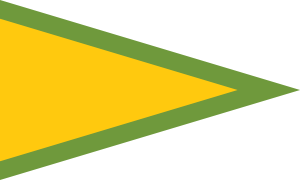
The "Post-Angkor Period" or "Middle Period" of Cambodia lasted from the early 15th century to 1863. This was when the French Protectorate of Cambodia began. There are very few reliable records for the 15th and 16th centuries. So, historians don't have one clear explanation for why the Khmer Empire declined. Most modern historians believe it was a mix of changes. These included religious, royal family, government, and military shifts. Environmental problems and changes in power in Indochina also played a part. Recently, studies have focused on climate change and its effects on the environment.
Writings on temple walls stop in the early 14th century and don't start again until the mid-16th century. The list of kings also stops with King Jayavarman IX Parameshwara. There are no records of a king's name for over 200 years. Building large temples stopped after Jayavarman VII's rule. Historian Michael Vickery says that for the 15th century, we only have outside sources. These include Chinese records and early Thai royal chronicles.
A key event in the 15th century was a Siamese (Thai) attack on the capital Yasodharapura (Angkor Thom) around 1431. Historians link this event to Cambodia's political center moving south. It shifted to the regions of Phnom Penh, Longvek, and later Oudong.
There are more sources for the 16th century. The kingdom was centered on the Mekong River. It was doing well as part of the Asian sea trade network. This is when Europeans first made contact with Cambodia. Wars with the Siamese led to loss of land. The capital Longvek was conquered in 1594. The Vietnamese, moving south, reached Prei Nokor/Saigon in the Mekong Delta in the 17th century. This started Cambodia's slow loss of access to the sea and independent trade.
Siamese and Vietnamese power grew in the 17th and 18th centuries. This led to the Cambodian capital moving often. The Khmer royal family became less powerful, like a vassal state. In the early 19th century, with strong dynasties in Vietnam and Siam, Cambodia lost its independence. It was controlled by both. A British agent, John Crawfurd, noted that the King of Cambodia was ready to seek protection from any European nation. To save Cambodia from being taken over by Vietnam and Siam, King Ang Duong accepted France's offer of protection. This officially began on August 11, 1863, when King Norodom Prohmbarirak signed the agreement.
Vietnamese Control (1811–1845)
The Vietnamese empire grew strong in the east. Cambodia fell under Vietnamese control in 1811. This happened after King Ang Chan II (r. 1806–35) asked Vietnamese Emperor Gia Long for help. King Chan wanted to stop his brothers, Ang Snguon and Ang Em, who were rebelling against him. The brothers fled to Thailand, and Ang Chan became a Vietnamese vassal.
In 1820, Gia Long died, and his son Minh Mang became emperor. Minh Mang was a strong ruler who believed in Confucian ideas. In 1832, he removed the Vietnamese governor of Cambodia. This led to a rebellion against him in 1833. The Thai army supported the rebellion. They attacked Vietnamese forces in Cambodia, forcing King Chan to flee. In 1834, the rebellion was put down. Minh Mang ordered a second invasion of Cambodia. Vietnamese troops pushed back the Thai forces and put Ang Chan back on the throne as a puppet king. His daughter, Queen Ang Mey (r. 1835–41), later took over.
The Vietnamese then established the Tây Thành Province. This meant Cambodia was directly controlled by Vietnam. For six years, the Vietnamese emperor tried to make Cambodians adopt Vietnamese culture. This was called the "Vietnamization of Cambodia."
Minh Mang's death in early 1841 stopped this process. About 35,000 Thai troops took advantage of Vietnam's problems. They entered Tây Thành Province and fought off Vietnamese attacks in late 1845. The new Vietnamese emperor, Thieu Tri, made peace with Siam. A peace treaty was signed in June 1847. The Kingdom of Cambodia, under Ang Duong, became independent again after 36 years of Vietnamese control and Thai interference.
French Colonial Period (1863–1953)
In August 1863, King Norodom signed an agreement with France. This placed Cambodia under French protection. At first, Cambodia kept its independence. But French control slowly increased over the years. By the end of the 19th century, the king had almost no power outside his palace. Norodom died in 1904. His successors, Sisowath and Monivong, allowed the French to control the country.
In 1940, France lost a short border war with Thailand. France was forced to give up the provinces of Battambang and Angkor. King Monivong died in April 1941. The French then put the young Prince Sihanouk, who was 18, on the throne. They thought he would be easier to control than Monivong's older son.
After World War II, Cambodia was in a difficult situation. The Free French wanted to get Indochina back. They offered Cambodia some self-government. They imagined Indochina joining a "French Union" where former colonies shared French culture.
Sihanouk's Rule (1953–70)
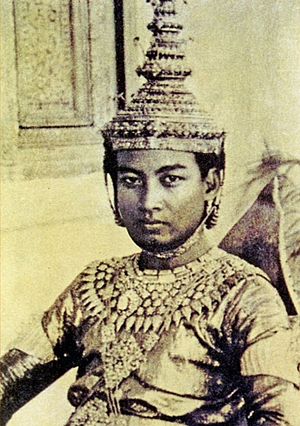
On March 9, 1945, during the Japanese occupation of Cambodia, young King Norodom Sihanouk declared Cambodia an independent kingdom. The Japanese government also recognized Cambodia's independence. The new government stopped the French plan to write the Khmer language using Roman letters. Instead, they brought back the traditional Khmer script. This decision was popular and lasted, as no Cambodian government has tried to change it since.
After the war, Allied forces disarmed and sent home the Japanese troops. The French then took back control of Phnom Penh in October of that year.
Sihanouk worked hard for Cambodia's independence. France eventually agreed to transfer power. A partial agreement was made in October 1953. Sihanouk then announced that independence had been achieved. He returned to Phnom Penh in triumph. The Geneva Conference on Indochina helped Cambodia. It led to the withdrawal of Viet Minh troops and protected Cambodia's independence from outside powers.
Cambodia's foreign policy in the 1950s and 1960s was to stay neutral. By the mid-1960s, parts of eastern Cambodia were used as bases by North Vietnamese Army (NVA) and National Liberation Front (NLF) forces. These forces were fighting against South Vietnam. The port of Sihanoukville was used to supply them. As NVA/VC activity grew, the United States and South Vietnam became worried. In 1969, the United States began bombing these NVA/VC areas. This bombing contributed to the country's instability. The bombing happened within 10 to 20 miles (16 to 32 km) of the Cambodian border. The Cambodian population had already been moved out of these areas by the NVA.
Prince Sihanouk was concerned that the war between North and South Vietnam might spread into Cambodia. He publicly opposed the US bombing campaign. However, some reports suggest Sihanouk privately told US officials he would not object to bombing Vietnamese communist bases, as long as Cambodians were not killed. Sihanouk wanted Cambodia to stay out of the conflict. He was also critical of the US government and its allies. He did not allow the US to use Cambodian airspace or airports for military purposes. This angered the US, making them see Sihanouk as sympathetic to North Vietnam. Yet, declassified documents show that the US still hoped for "friendly relations" with Sihanouk in March 1970.
Throughout the 1960s, Cambodian politics became divided. Opposition to the government grew among the middle class and left-wing groups. Leaders like Son Sen, Ieng Sary, and Saloth Sar (later known as Pol Pot) led a rebellion. This was under the secret Communist Party of Kampuchea (CPK). Sihanouk called these rebels the Khmer Rouge, meaning "Red Khmer." In 1966, elections showed a shift to the right. General Lon Nol formed a new government. The rebellion grew worse in 1968 and 1969. Some government and army members disliked Sihanouk's ruling style and his move away from the US. They had reasons to overthrow him.
Khmer Republic and the War (1970–75)
In 1970, while visiting Beijing, Sihanouk was removed from power by a military coup. This coup was led by Prime Minister General Lon Nol and Prince Sisowath Sirik Matak on March 18, 1970. The CIA had known about the army's readiness for a coup since March 12. Lon Nol took power and quickly allied Cambodia with the United States. On October 9, the Cambodian monarchy was ended, and the country was renamed the Khmer Republic. The new government immediately demanded that Vietnamese communists leave Cambodia.
Hanoi refused to withdraw its NVA troops. In response, the United States began providing military aid to the new government. This government was fighting both CPK rebels and NVA forces. The North Vietnamese and Viet Cong forces wanted to keep their bases and supply lines. They immediately attacked the new government. The North Vietnamese quickly took over large parts of eastern Cambodia. They reached within 15 miles (24 km) of Phnom Penh. The North Vietnamese then gave these newly won areas to the Khmer Rouge. The king urged his followers to help overthrow this new government. This sped up the start of the civil war.
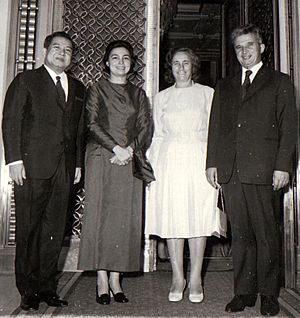
In April 1970, US President Richard Nixon announced that US and South Vietnamese ground forces had entered Cambodia. This was to destroy NVA base areas. The US had already been bombing Vietnamese positions in Cambodia for over a year. Although much equipment was seized or destroyed, containing North Vietnamese forces proved difficult.
The Khmer Republic's leaders had problems working together. These were Lon Nol, Sihanouk's cousin Sirik Matak, and National Assembly leader In Tam. Lon Nol stayed in power partly because no one else was ready to take his place. In 1972, a constitution was adopted, a parliament was elected, and Lon Nol became president. But disunity, the challenge of turning a 30,000-man army into a 200,000-man force, and growing corruption weakened the government and army.

The Khmer Rouge rebellion inside Cambodia continued to grow. It was helped by supplies and military support from North Vietnam. Pol Pot and Ieng Sary took control over the Vietnamese-trained communists. Many of these were removed from power. At the same time, the Khmer Rouge (CPK) forces became stronger and more independent from their Vietnamese helpers. By 1973, the CPK was fighting government forces with little or no North Vietnamese help. They controlled almost 60% of Cambodia's land and 25% of its people.
The government tried three times to negotiate with the rebels, but failed. By 1974, the CPK was operating openly as large units. Some NVA combat forces had moved into South Vietnam. Lon Nol's control was limited to small areas around cities and main roads. More than two million war refugees lived in Phnom Penh and other cities.
On New Year's Day 1975, Communist troops launched an attack. After 117 days of hard fighting, the Khmer Republic collapsed. Attacks around Phnom Penh trapped government forces. Other CPK units took over bases controlling the vital Mekong supply route. A US-funded airlift of supplies ended when Congress refused more aid. The Lon Nol government in Phnom Penh surrendered on April 17, 1975. This was just five days after the US mission left Cambodia.
Outside Influence on the Khmer Rouge
Historians have studied the link between the huge US bombing of Cambodia and the growth of the Khmer Rouge. Some, like Ben Kiernan, believe the US bombing campaign (1965–1973) was a big reason for increased support for the Khmer Rouge among Cambodian farmers. Kiernan states that the Khmer Rouge "would not have won power without U.S. economic and military destabilization of Cambodia." He adds that they used the bombing's destruction and civilian deaths as propaganda. This helped them recruit members and excused their harsh policies.
Pol Pot's biographer, David P. Chandler, wrote that the bombing did break the Communist hold around Phnom Penh. But it also sped up the breakdown of rural society and increased social divisions. Peter Rodman and Michael Lind argued that US intervention saved the Lon Nol government in 1970 and 1973. Craig Etcheson agreed that US intervention increased Khmer Rouge recruitment. However, he disagreed that it was the main cause of their victory. William Shawcross wrote that the US bombing and ground invasion pushed Cambodia into chaos. This was something Sihanouk had tried to avoid for years.
By 1973, Vietnamese support for the Khmer Rouge had mostly disappeared. China "armed and trained" the Khmer Rouge during the civil war and after.
Because of support from China, the US, and other Western countries, the Khmer Rouge-led Coalition Government of Democratic Kampuchea (CGDK) kept Cambodia's UN seat until 1993. This was long after the Cold War ended. China has defended its ties with the Khmer Rouge. A Chinese Foreign Ministry spokeswoman said that "the government of Democratic Kampuchea had a legal seat at the United Nations." She added that it had "established broad foreign relations with more than 70 countries."
Democratic Kampuchea (Khmer Rouge Era) (1975–79)
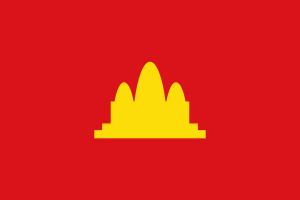
Right after their victory, the CPK ordered everyone to leave cities and towns. They sent the entire city population to the countryside to work as farmers. The CPK wanted to completely change Cambodian society, following Pol Pot's ideas.
The new government aimed to rebuild Cambodian society from scratch. Old ways of life were abolished, and religion was suppressed. Farming was organized into large collective farms. The remaining factories were either abandoned or controlled by the state. Cambodia had no money or banking system.
Democratic Kampuchea's relations with Vietnam and Thailand quickly worsened. This was due to border fights and different political ideas. The CPK was very nationalistic, even though they were communist. Many members who had lived in Vietnam were removed from power. Democratic Kampuchea became close with China. The conflict between Cambodia and Vietnam became part of the rivalry between China and the Soviet Union, with Moscow supporting Vietnam. Border clashes got worse when the Democratic Kampuchea military attacked villages in Vietnam. The regime broke off relations with Hanoi in December 1977. They protested Vietnam's alleged attempt to create an Indochina Federation. In mid-1978, Vietnamese forces invaded Cambodia. They advanced about 30 miles (48 km) before the rainy season stopped them.
China supported the CPK to prevent a strong, unified Indochina. They also wanted to keep their military power in the region. The Soviet Union supported a strong Vietnam. This was to create another front against China if there were hostilities. It also aimed to stop further Chinese expansion. Relations between China and the Soviet Union had been difficult since Stalin's death. In February to March 1979, China and Vietnam fought a short war over these issues.
In December 1978, Vietnam announced the creation of the Kampuchean United Front for National Salvation (KUFNS). This group was led by Heng Samrin, a former DK commander. It included Khmer Communists who had stayed in Vietnam after 1975. It also had officials from eastern Cambodia, like Heng Samrin and Hun Sen, who had fled to Vietnam in 1978. In late December 1978, Vietnamese forces launched a full invasion of Cambodia. They captured Phnom Penh on January 7, 1979. They pushed the remaining Democratic Kampuchea army westward towards Thailand.
Within the CPK, the leaders who had studied in Paris were in control. These included Pol Pot, Ieng Sary, Nuon Chea, and Son Sen. A new constitution in January 1976 established Democratic Kampuchea as a Communist People's Republic. A 250-member Assembly was chosen in March. This assembly picked the collective leadership of a State Presidium. Its chairman became the head of state.
Prince Sihanouk resigned as head of state on April 2. On April 14, the Assembly announced that Khieu Samphan would chair the State Presidium for a 5-year term. It also chose a 15-member cabinet led by Pol Pot as prime minister. Prince Sihanouk was placed under house arrest.
Vietnamese Occupation and the PRK (1979–93)
On January 10, 1979, the Vietnamese army and the KUFNS (Kampuchean United Front for National Salvation) invaded Cambodia. They overthrew the Khmer Rouge. The new People's Republic of Kampuchea (PRK) was established with Heng Samrin as head of state. Pol Pot's Khmer Rouge forces quickly retreated to the jungles near the Thai border. The Khmer Rouge and the PRK began a difficult struggle. This conflict was influenced by larger powers: China, the United States, and the Soviet Union.
The Khmer People's Revolutionary Party's rule led to a guerrilla movement. This movement had three main resistance groups. These were FUNCINPEC, the KPLNF, and the PDK (the Khmer Rouge). All these groups had different ideas about Cambodia's future. The civil war forced 600,000 Cambodians to flee to refugee camps along the Thai border. Many thousands of people suffered greatly across the country.
Peace efforts began in Paris in 1989. This was under the State of Cambodia. These efforts led to a peace agreement in October 1991. The United Nations was given the job of enforcing a ceasefire. They also had to help refugees, disarm armies, and prepare the country for free and fair elections. This mission was called the United Nations Transitional Authority in Cambodia (UNTAC).
Modern Cambodia (1993–Present)

On October 23, 1991, the Paris Conference met again. They signed a full peace agreement. This gave the UN complete power to oversee a ceasefire. It also allowed the UN to help displaced Cambodians return home from Thailand. The UN was to disarm and demobilize the different armies. Finally, it would prepare the country for free and fair elections. Prince Sihanouk, head of the Supreme National Council of Cambodia (SNC), returned to Phnom Penh in November 1991. This began the process of resettlement in Cambodia. The UN Advance Mission for Cambodia (UNAMIC) was also sent. Its job was to connect the different groups and start clearing landmines. This helped about 370,000 Cambodians return from Thailand.
On March 16, 1992, the United Nations Transitional Authority in Cambodia (UNTAC) arrived in Cambodia. It began to carry out the UN peace plan. UNTAC became fully active on March 15, 1992, under Yasushi Akashi. UNTAC grew into a large force of 22,000 civilian and military peacekeepers. Their main task was to ensure free and fair elections for a new assembly.
Over 4 million Cambodians voted in the May 1993 elections. This was about 90% of eligible voters. Before the election, there was widespread violence and threats. This was mainly caused by the State of Cambodia (SOC) security forces. They targeted the FUNCINPEC and BLDP parties. The Khmer Rouge (PDK) did not disarm or demobilize their forces. They also blocked access to polling places in some areas. Prince Norodom Ranariddh's (Sihanouk's son) royalist Funcinpec Party received the most votes (45.5%). Hun Sen's Cambodian People's Party and the Buddhist Liberal Democratic Party followed. Funcinpec then formed a coalition with the other parties that participated. A coalition government was formed between the Cambodian People's Party and FUNCINPEC. It had two co-prime ministers: Hun Sen, who had been prime minister in the Communist government since 1985, and Norodom Ranariddh.
The parties in the 120-member assembly wrote and approved a new constitution. It was officially announced on September 24, 1993. This constitution created a multi-party democracy with a constitutional monarchy. The former Prince Sihanouk became King. Prince Ranariddh and Hun Sen became First and Second Prime Ministers. The constitution also includes many internationally recognized human rights.
Hun Sen and his government have faced much discussion. Hun Sen was a former Khmer Rouge commander. He was originally put in power by the Vietnamese. After the Vietnamese left, he kept his strong position. In 1997, he launched a coup. He used the army to remove Ranariddh and his supporters. Ranariddh was forced out and fled to Paris. Other opponents of Hun Sen were arrested, and some were executed.
On October 4, 2004, the Cambodian National Assembly approved an agreement with the United Nations. This agreement was to set up a court to try senior leaders responsible for the terrible acts committed by the Khmer Rouge. International donor countries promised $43 million for the court's budget. Cambodia contributed $13.3 million. The court has sentenced several senior Khmer Rouge leaders since 2008.
Cambodia still has many landmines. These were placed by all sides during the decades of war.
Images for kids
-
This stone slab (stele) found in Vietnam. It has Sanskrit writing from the 5th century AD.
See also
 In Spanish: Historia de Camboya para niños
In Spanish: Historia de Camboya para niños




